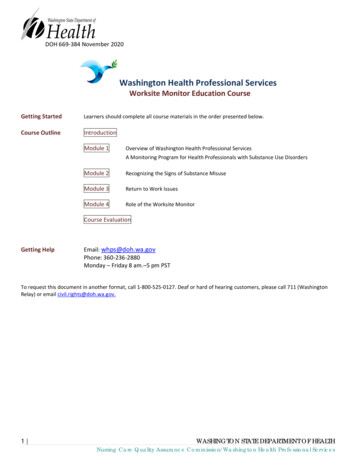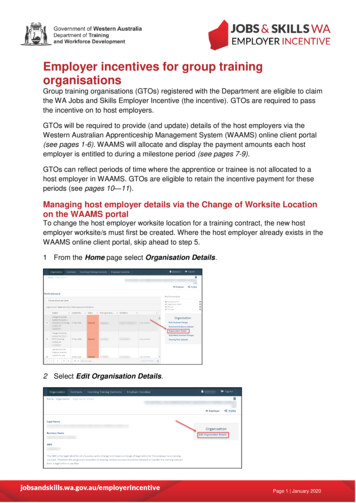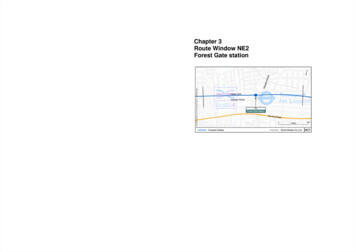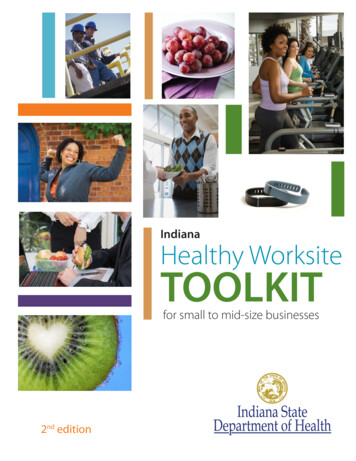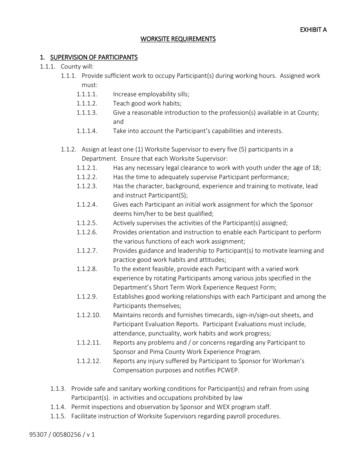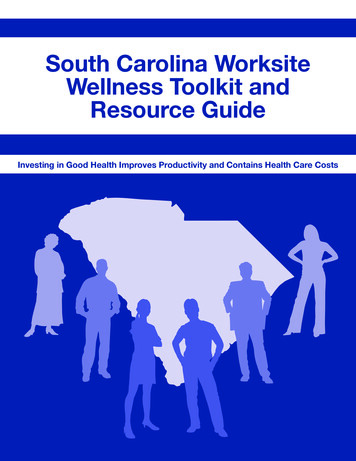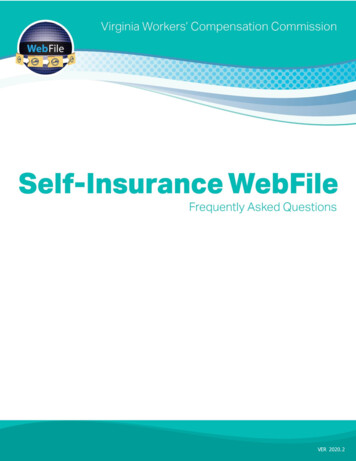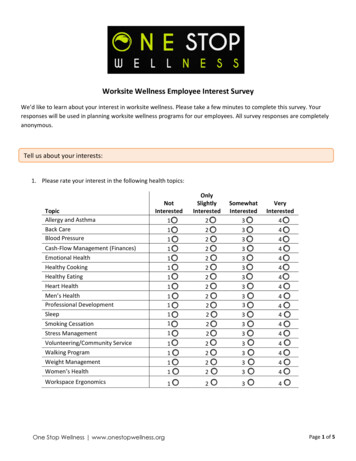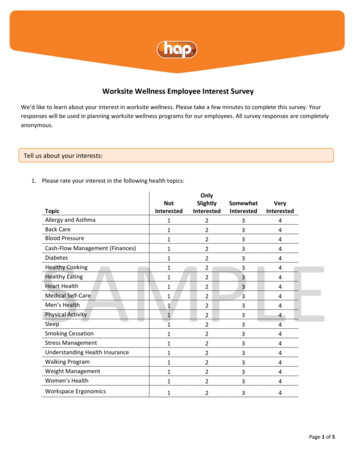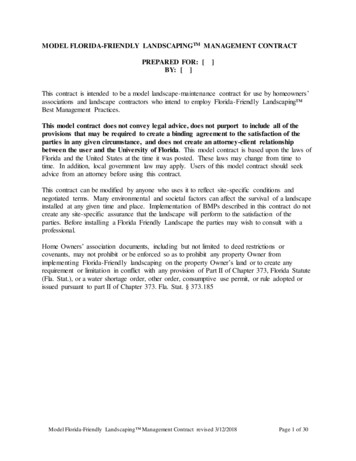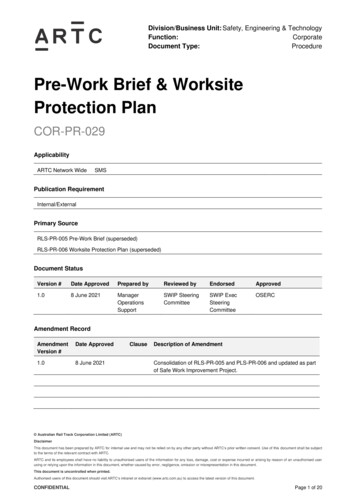
Transcription
Division/Business Unit: Safety, Engineering & TechnologyFunction:CorporateDocument Type:ProcedurePre-Work Brief & WorksiteProtection PlanCOR-PR-029ApplicabilityARTC Network WideSMSPublication RequirementInternal/ExternalPrimary SourceRLS-PR-005 Pre-Work Brief (superseded)RLS-PR-006 Worksite Protection Plan (superseded)Document StatusVersion #Date ApprovedPrepared byReviewed byEndorsedApproved1.08 June 2021ManagerOperationsSupportSWIP SteeringCommitteeSWIP ExecSteeringCommitteeOSERCAmendment RecordAmendmentVersion #Date Approved1.08 June 2021ClauseDescription of AmendmentConsolidation of RLS-PR-005 and PLS-PR-006 and updated as partof Safe Work Improvement Project. Australian Rail Track Corporation Limited (ARTC)DisclaimerThis document has been prepared by ARTC for internal use and may not be relied on by any other party without ARTC’s prior written consent. Use of this document shall be subjectto the terms of the relevant contract with ARTC.ARTC and its employees shall have no liability to unauthorised users of the information for any loss, damage, cost or expense incurred or arising by reason of an unauthorised userusing or relying upon the information in this document, whether caused by error, negligence, omission or misrepresentation in this document.This document is uncontrolled when printed.Authorised users of this document should visit ARTC’s intranet or extranet (www.artc.com.au) to access the latest version of this document.CONFIDENTIALPage 1 of 20
Pre-Work Brief & Worksite Protection PlanCOR-PR-029Table of ContentsTable of Contents . 21Introduction . 31.1Purpose . 31.2Scope . 31.3Procedure Owner . 31.4Responsibilities . 31.5Subordinate Documents . 61.6Reference Documents . 61.7Definitions . 62Worksite Safety Management Requirements . 93Pre Work Brief.11453.1Team Member Induction Requirements .113.2When is a Pre Work Brief Required? .113.3Who must deliver the Pre Work Brief? .113.4Preparing and Delivering a Pre Work Brief .12Worksite Protection Plan .134.1Who is responsible for preparing the Worksite Protection Plan? .134.2When is the Worksite Protection Plan required? .134.3Preparing a Worksite Protection Plan .144.4Location Validation Requirements .164.5Mandatory items to be included in the Diagram .174.6Additional Items to be identified in the Diagram .174.7Changes to a Worksite Protection Plan .184.8Individual Working Alone (IWA) .18Recording Safety Critical Information .195.1Worksite Log and Diary .196Record Keeping .197Monitoring and Inspection .20This document is uncontrolled when printed.Version Number: 1.0Date Approved: 8 June 2021Page 2 of 20
Pre-Work Brief & Worksite Protection PlanCOR-PR-029Introduction1 Introduction1.1PurposeThe purpose of this procedure is to:1.2 Identify and define the roles and requirements that exist as part of the pre work brief process; Document the relationship between the pre work brief and worksite protection plan brief; and Identify and define the roles and requirements that exist as part of the worksite protectionplan process.ScopeThis procedure is applicable to all work requiring entry within the ARTC rail corridor. Thisprocedure applies to all ARTC workers and contractors who are responsible for managingworksites within the ARTC rail corridor.1.3Procedure OwnerThe General Manager Safety & Environment is the Procedure Owner. The Corporate PrincipalSafety Manager is the initial point of contact for all queries relating to this procedure.1.4ResponsibilitiesLeaders are responsible for: Ensuring appropriate inductions have been undertaken prior to work commencing; Confirming that team members have the appropriate RIW competencies or roles; Nominating a Site Supervisor (SS) to prepare and deliver the pre work brief prior tocommencing the task, as detailed in this procedure and keeping a record of the pre workbriefings held; Nominating a Protection Officer/Track Force Protection Coordinator/Track Worker in Chargeof Protection (PO/TFPC/TW) to prepare the worksite protection plan and conduct a briefing toexplain the protection in place to the work team prior to commencing any task in the railcorridor; Reviewing the quality of pre work briefs; Ensuring there is access to Safe Work Method Statements (SWMS) or other safety relateddocumentation relevant to the task being undertaken;Ensure that workers are instructed in COR-PR-029, and any other relevant safety andoperational guidelines, SWMS etc identified for work areas, tasks or activities.Site Supervisor (SS) is responsible for: Prepare and deliver the pre work brief to all team members that attend the site on thehazards and controls that exist at the worksite and alerting the worksite of any new hazardsthat arise throughout the shift; Providing teams with opportunity to identify and document any hazards that exist at theworksite;This document is uncontrolled when printed.Version Number: 1.0Date Approved: 8 June 2021Page 3 of 20
Pre-Work Brief & Worksite Protection PlanCOR-PR-029 Providing teams with opportunity to identify and document any controls to be implemented toeliminate or contain hazards that exist at the worksite; Providing adequate information and allocating suitable time to the PO/TFPC/TW to allow asafe system of work to be developed encompassing the highest level of protection; Clarifying and questioning worksite protection arrangements that are not fully understood orto which team members think may not be adequate in managing the site risks; Having each team member sign the pre work briefing form (or if controls have beenimplemented removing the ability to sign, record the workers RIW card number) toacknowledge their understanding of health and safety issues and protection arrangements; Confirming controls as agreed and as set out in the pre work brief have been implementedand are in place; Confirming a trained first aider is on site and nominated within the pre work brief; Validating that the PO/TFPC/TW has implemented protection arrangements in accordancewith the WPP prior to allowing team members to commence any task in the rail corridor; and Pausing to stop & think. In the event of an incident, near miss or change, the Site Supervisoris to document any such changes before re-briefing the team regarding any identified hazardsand required controls prior to recommencing work. Implementing and monitoring adherence to Safe Work Method Statements and PPErequirements; Confirming worksite protection is in place and is suitable for the activity being undertaken; Monitoring the team’s activities confirming that the work that is being performed is completedto relevant expectations, standards and workplace health and safety legislation; Validating team members including contractors are competent to complete the task; Confirming with the PO/TFPC/TW at completion of works, that the track is handed back fit foruse and/or any restrictions have been notified to the Network Controller; In the event of an incident, immediately quarantining the site where required and notifyingtheir line leader within one hour per relevant Business Unit Notification processes; Ensuring that the Network Controller is contacted immediately where required; Contact line leader to arrange drug and alcohol testing where applicable.Protection Officer/Track Force Protection Coordinator/Track Worker in Charge ofProtection (PO/TFPC/TW) is responsible for: Ensuring controls are in place for prevention of unauthorised rail traffic from entering into theworksite protection limits; Conferring and providing adequate information to the Site Supervisor to allow a safe systemof work to be developed encompassing the highest level of protection; Understanding the:othe nature of the works to be undertaken;otype of equipment/machinery to be used; andopotential effect of works on track and/or adjacent lines;This document is uncontrolled when printed.Version Number: 1.0Date Approved: 8 June 2021Page 4 of 20
Pre-Work Brief & Worksite Protection PlanCOR-PR-029 Reviewing the related Network Information Books (NIBs) and validating the informationcontained within the NIBs on site; Preparing the worksite protection plan in accordance with this procedure and the relevantnetwork rules and procedures; Placing or directing a qualified team member to place, all protection on site in the locationrepresented within the worksite protection plan; Briefing all team members that attend the site on the worksite rail safety protectionarrangements that are in place; Engaging with a second team member to verify the worksite location is correct against theNIBs, using relevant track and kms, signal, landmark or structure; Engaging with a second team member to verify the protection arrangements are in place andare as documented in the worksite protection plan; Confirming team members and visitors understand the worksite rail safety protectionarrangements as detailed in the worksite protection plan and have an opportunity to clarifyprotection arrangements if not fully understood; Reviewing the worksite protection plan when changes to work activities increase the risk ofteam members being struck by rail traffic, or impacts the limits of protection; andStopping all works and moving team members to a safe place prior to briefing the team of anychange in worksite protection arrangements.All Team Members are responsible for: Clarifying pre work brief arrangements that are not fully understood or if the team memberthinks the controls may not be adequate in managing the site risks; Clarifying worksite protection arrangements that are not fully understood or if the teammembers think the protection may not be adequate in managing the site risks; Signing the pre work brief form to acknowledge their understanding of health and safetyissues, protection arrangements, site risks and controls and confirming their competency andfitness for work; Identifying and alerting the Site Supervisor of any hazards identified; When requested, assist by validating that the PO/TFPC/TW has implemented protectionarrangements in accordance with the WPP prior to commencing work in the rail corridor; Implementing and working within the control measures for hazards identified during the PWB; Following all safety and operational guidelines including SWMS etc. and confirming therelevant controls are implemented prior to commencing work; and Pausing to stop & think in the event of an incident, near miss or change in plan, process orprotection arrangements. Assess the change and notify the Site Supervisor prior torecommencing work.This document is uncontrolled when printed.Version Number: 1.0Date Approved: 8 June 2021Page 5 of 20
Pre-Work Brief & Worksite Protection PlanCOR-PR-0291.5Subordinate DocumentsThe following documents are subordinate to this procedure:1.6 COR-FM-058 Pre Work Brief Template COR-FM-059 Worksite Protection Plan Template COR-FM-060 Worksite Log and Diary. COR-FM-061 Worksite Protection Checklist EHS-WI-008 Individual Working Alone (IWA)Reference DocumentsThe following documents support this procedure:1.7 ARTC Network Rules and Procedures NCOP Code of Practice for the Defined Interstate Rail Network TA20 – ARTC Code of Practice for the Victorian Main Line Operations RSK-PR-001- Risk Management WHS-WI-311 - Work Method Statements SYS-PR-001 Records Management Procedure.DefinitionsThe following terms and acronyms are used within this document or subordinate documents:Term or acronymDescriptionARTCAustralian Rail Track CorporationCorridor Access ApprovalA reference number allocated by ARTC to a work team that has preapproval to enter the ARTC Corridor.Danger ZoneEverywhere within 3m horizontally from the nearest rail and any distanceabove or below this 3m, unless a safe place exists or has been created.HandsignallerA Competent Worker who gives hand signals to Rail Traffic Crews.IWAIndividual Working AloneLeaderA Line Manager responsible for workers, which within ARTC can includebut is not limited to an Area Manager, Project Manager, Project Engineer,Team Leader or Work Group LeaderA PO/TFPC/TW responsible for keeping watch for approaching rail traffic,and for warning other workers to stand clear of the line before the arrival ofrail traffic.LookoutNetwork ControlThe function responsible for managing train paths and issuing occupancyauthorities.NCNetwork Controller. A Competent Worker who authorises, and may issue,occupancies and Proceed Authorities, and who manages train paths toensure safe and efficient transit of rail traffic in the ARTC NetworkThis document is uncontrolled when printed.Version Number: 1.0Date Approved: 8 June 2021Page 6 of 20
Pre-Work Brief & Worksite Protection PlanCOR-PR-029Term or acronymDescriptionNetwork Control Officer orNCOA Network Controller for an unattended location, a Signaller or NetworkController for a controlled location, or a delegate carrying out somefunctions of a Network Controller or Signaller.Officer in ChargePerson in charge of the shunting yard, or location (e.g. TerminalCoordinator);PPEPersonal Protective EquipmentTeam member responsible for preventing unauthorised rail traffic enteringthe worksite limits. The PO/TFPC/TW will populate and deliver the worksiteprotection brief.PO/TFPC/TWA PO/TFPC/TW is known as: Protection Officer (PO) in NSW and Queensland; Track Force Protection Coordinator (TFPC) in Victoria; Track Worker in Charge of Protection in South Australia and WesternAustralia.PWBPre Work BriefRail CorridorEverywhere within 15 metres of the outermost rails or the boundary fence where boundary fences are provided and are closerthan 15 metres, or if the property boundary is less than 15 metres, the property boundary, or a permanent structure such as a fence, wall or level crossing separatingthe operating rail corridor from leased or non-operational land.REFReview of Environmental FactorsRIWRail Industry WorkerRail industry system allowing visibility and confirmation of role andcompetency of rail workersSWMSSafe Work Method StatementSSSite SupervisorNominated team member ARTC or contractor responsible for managingworksite safety processes. The Site Supervisor will populate and deliver thepre work brief.Team memberAny person including ARTC employees, contractors, subcontractors, thirdparties labour hire employees or visitors to the worksite/locationWMSWork Method StatementWPPWorksite Protection PlanNew South Wales OnlyPOProtection Officer levels 1, 2, 3 and 4PPOPossession Protection OfficerLPALocal Possession AuthorityTOATrack Occupancy AuthorityThis document is uncontrolled when printed.Version Number: 1.0Date Approved: 8 June 2021Page 7 of 20
Pre-Work Brief & Worksite Protection PlanCOR-PR-029Term or acronymDescriptionTWATrack Work AuthorityASBAbsolute Signal BlockingLOWLookout WorkingWICWork Inside the Corridor and outside the danger zoneVictoria OnlyTFPCTrack Force Protection CoordinatorAOAbsolute OccupationASBAbsolute Signal BlockingTWWTrack Warrant WorkingTFPTrack Force ProtectionLOWLookout WorkingSouth Australia (Wolseley to Tailem Bend), Western Australia, Dimboola (exclusive) westernVictoria OnlyTWTrack Worker - Level 1 to Level 4STWSenior Track Worker – Safe Working Level 1LPLocal PossessionTOATrack Occupancy AuthorityTWATrack Work AuthorityTRITrain Running InformationLNARNo Authority RequiredThis document is uncontrolled when printed.Version Number: 1.0Date Approved: 8 June 2021Page 8 of 20
Pre-Work Brief & Worksite Protection PlanCOR-PR-0292 Worksite Safety Management RequirementsAny work that is undertaken within the ARTC rail corridor will require an assessment of the risk tobe completed. Any hazards that are identified must be eliminated or controlled prior to workscommencing. For work within the ARTC rail corridor, this is completed in two ways: Pre Work Brief (PWB); and Worksite Protection Plan (WPP).The below table identifies the risk assessment process, related form and who is e Work Brief TemplateSite SupervisorPrior to work commencing and on any change incontrols, or identification of other hazardsCOR-FM-059Worksite Protection Plan TemplatePO/TFPC/TWPrior to work commencing and on any change incontrolsCOR-FM-060Worksite Log and DiaryPO/TFPC/TWPrior to work commencing and on any change incontrols and for any other safety criticalcommunications with NC, PPO, other worksite etc.COR-FM-061Worksite Protection ChecklistLeader or anyworkerDuring any works undertaken within the railcorridor, providing assurance to the processNOTE:Where a PO/TFPC/TW has been engaged solely to exclude rail traffic and is not also filling the role ofSite Supervisor, there is no need for the PO/TFPC/TW to complete a PWB. In this circumstance thePO/TFPC/TW would only complete a WPP and the Site Supervisor would complete the PWB.Site Supervisor and the PO/TFPC/TW may use either a paper copy or an electronic version of the prework brief, worksite protection plan and the worksite log and diary.The flow chart on the following page articulates the roles, document and when they are required tobe used.This document is uncontrolled when printed.Version Number: 1.0Date Approved: 8 June 2021Page 9 of 20
Pre-Work Brief & Worksite Protection PlanCOR-PR-029This document is uncontrolled when printed.Version Number: 1.0Date Approved: 8 June 2021Page 10 of 20
Pre-Work Brief & Worksite Protection PlanCOR-PR-0293 Pre Work Brief3.1Team Member Induction RequirementsARTC has an induction process in place to provide employees, contractors and consultants withcritical information relevant to their engagement. This is articulated within PEO-PR-002 InductionProcedure.These induction requirements are further expanded when work is required to be undertakenwithin the ARTC rail corridor. Requirements related to work undertaken within the rail corridor arearticulated within RLS-PR-003 Protocol for Entering the Rail Corridor.Specific projects, work activities or locations may have additional induction requirements.3.2When is a Pre Work Brief Required?A Pre Work Brief (PWB) is an additional requirement to induction training. This providesopportunity for all team members to be briefed and made aware of the risks and hazards thatexist on site, as well as the controls that are in place to eliminate or contain them. It also presentsopportunity for the work team to raise any hazards they identify, as well as nominate any furthercontrols that should be in place prior to commencing work, to protect the team.As a minimum requirement, pre work briefings must be performed at a minimum, at the start ofeach shift and prior to any work activities when working within the rail corridor.Additional briefings must be conducted where: The hazards change from those identified in the initial briefing; The control measures change in type, timing, detail; Where different work is performed to the work that was planned; When the location of work changes, or Where a PWB has been undertaken and a significant delay has been experienced incommencement of work, the PWB must be reviewed with any changes recorded.The pre work brief template or an equivalent approved document must be used as a hazardassessment tool for any high risk construction work undertaken outside of the rail corridor, forexample activities undertaken within provisioning centres, or other ARTC worksites buildings orfacilities.3.3Who must deliver the Pre Work Brief?A person must be nominated by a Leader as the Site Supervisor (SS), and it is this person who isto prepare and deliver a PWB to all team members who attend the location. The site supervisor isresponsible for monitoring and managing worksite health and safety processes. The sitesupervisor uses the pre work brief to inform all team members so they understand the workactivity being undertaken, including their roles and responsibilitiesWhere ARTC has appointed a Principal Contractor, with an approved work health and safetymanagement system, there is no need to complete the ‘site specific hazards and controls’ sectionof the pre work brief. The contractors work health and safety management systems must be usedThis document is uncontrolled when printed.Version Number: 1.0Date Approved: 8 June 2021Page 11 of 20
Pre-Work Brief & Worksite Protection PlanCOR-PR-029in place of the hazard and controls section of the PWB. if they are contained within that induction.Reference should be made on the pre work brief documentation that this has occurred. This is toremove duplication and inconsistency where hazards are incorporated within the site-specificinduction.Any additional hazards identified, or controls implemented should be documented and briefed tothe team prior to commencing work.3.4Preparing and Delivering a Pre Work BriefThere are five sections that must be completed and included within a pre work brief.StepSectionDescription & Instruction1Site DetailsIdentifies the following information: work location, date, time and scope; name and signature of Site Supervisor; name of PO/TFPC/TW; name of allocated Plant Supervisor where applicable the Network Controller’s emergency contact number; nominated first aider’s name and location of the first aid kit; emergency assembly point, as well as type of emergency warningalarm that is in place (and tested) emergency services access point;2HazardIdentificationCommon hazards that may need to be controlled. If it is identified that ahazard from this list has not been controlled (selected a grey square),workers must not commence work until the appropriate control measures arein place;3Site SpecificHazards &ControlsAllows the Site Supervisor to identify and record site specific hazards againstARTC’s Fatal and Severe Risks matrix along with any other hazards(safety/environment/community/weather related) and associated controlsimplemented.Site Supervisor must identify the hazard before developing & recording thecontrols to be implemented to contain the risk. The relevant fatal and severerisks can be ticked if relevant. Once identified as relevant, the risk must becontrolled.The Site Supervisor must engage with all team members on site to identifyany additional site-specific hazards and record these hazards on the prework brief.Once site specific hazards have been identified, controls and Life SavingBehaviours that are required to be adopted will be recorded on the pre workbrief and explained to all team members on site.Each team member has the opportunity and responsibility to identify hazardsthat they consider are a risk as well as related controls required.4Sign Off &VerificationThis document is uncontrolled when printed.Must be signed by all team members operating under the control of the prework brief. In the event the pre work brief is not to be signed, the SiteSupervisor must document the workers Rail Industry Worker card number.Version Number: 1.0Date Approved: 8 June 2021Page 12 of 20
Pre-Work Brief & Worksite Protection PlanCOR-PR-029This section verifies that all team members:5ChangeManagementAssessment are free of alcohol and or and advised the site supervisor of anymedication that may affect their ability to perform work safely; Are free of the effects of fatigue or illness and are fit for work; have been briefed on relevant safe work method statements,procedures, hazards and controls and had opportunity to identifyany new hazards and controls to be implemented; and have reviewed the worksite protection arrangements in place.This is to be completed when a work group move location and the type andscope of work is not changingThe Site Supervisor is to ensure all sections of the pre work brief are completed and a worksiteprotection plan is prepared, implemented and a brief delivered by a PO/TFPC/TW . All teammembers attending the site must receive this briefing and sign the verification section, on thePWB, prior to commencing work. Each team member attending the site must record the sign intime in the column provided. When the work is complete, or when a team member is leaving site,the team member must record the sign out time in the column provided. The Site Supervisor willthen inform the PO/TFPC/TW who may then commence handback of the worksite with the NC.This requirement may be undertaken using electronic sign in and sign out facilities on site suchas RIW and when used this must be documented on the pre work brief form. When a site is notphysically signing the pre work brief, the Site Supervisor can record the workers RIW cardnumber along with the sign in and sign out times in the pre work brief.4 Worksite Protection Plan4.1Who is responsible for preparing the Worksite Protection Plan?The worksite protection plan must be prepared, implemented, and communicated via briefing by aqualified PO/TFPC/TW. The primary role of the PO/TFPC/TW is to exclude rail traffic from theworksite, protecting the work team and preventing any unauthorised rail traffic from entering theworksite limits. This requires the PO/TFPC/TW to identify any entry points and put controls inplace to prevent entry in line with the relevant Network Rules and Procedures. This must formpart of the documented worksite protection plan. The PO/TFPC/TW must utilise the relevantNetwork Information Books (NIBs) for the section of track where the worksite is to be located.It is the responsibility of the PO/TFPC/TW to prepare and deliver the worksite protection brief toall team members working at a worksite, within the rail corridor this will occur as part of the ‘prework brief’ undertaken by the Site Supervisor. This will be undertaken in conjunction with the prework brief articulated in section 3.3.All team members must be given an opportunity to clarify the worksite protection arrangements inplace if not fully understood.4.2When is the Worksite Protection Plan required?A worksite protection plan is required to be completed on every occasion that work is beingundertaken within the rail corridor.This document is uncontrolled when printed.Version Number: 1.0Date Approved: 8 June 2021Page 13 of 20
Pre-Work Brief & Worksite Protection PlanCOR-PR-029When any change in protection arrangements occurs that alters the original protection plan, workmust be stopped and the work team moved to a safe place. The PO/TFPC/TW must then re-briefthe team on the modifications prior to the team recommencing work.If there are multiple worksites utilising different methods of protection, a coordinatingPO/TFPC/TW must be nominated and identified. The coordinating PO/TFPC/TW holds theoverarching authority for the numerous worksites and will ensure that the PO/TFPC/TW on eachindividual worksite are aware of the protection arrangements.4.3Preparing a Worksite Protection PlanStepSectionDescription & Instruction1Worksite DetailsList the date the work is being undertakenThe start time the protection is scheduled to commence.Define the worksite location by kilometre and signal number if applicable.Site Supervisor Name and Phone number, identifies the team membernominated by the Leader responsible for monitoring and managing worksitehealth and safety process
Confirming team members and visitors understand the worksite rail safety protection arrangements as detailed in the worksite protection plan and have an opportunity to clarify protection arrangements if not fully understood; Reviewing the worksite protection plan when changes to work activities increase the risk of

